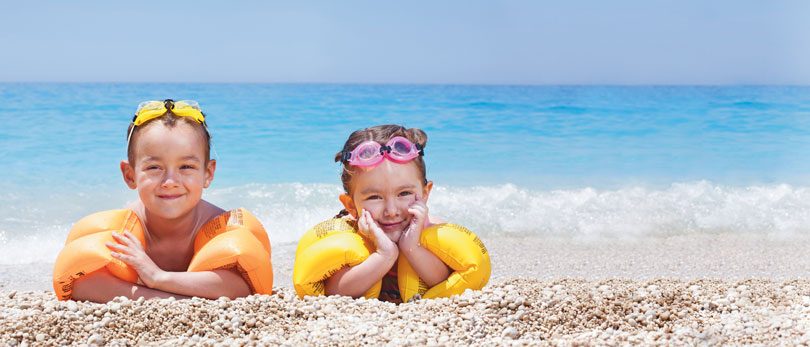The temperatures are warmer, the days are longer, and best of all—school is out. It’s time for summer fun! Don’t let summer hazards put a damper on family fun this season. Follow these tips for a safe and healthy summer.
SUN
 Did you know that just a few serious childhood sunburns can increase your risk of skin cancer later in life? And, it isn’t just on sunny days that children (and adults) can get sunburn. Avoid sunburn all summer long with the following recommendations:
Did you know that just a few serious childhood sunburns can increase your risk of skin cancer later in life? And, it isn’t just on sunny days that children (and adults) can get sunburn. Avoid sunburn all summer long with the following recommendations:
- Apply (and reapply!) sunscreen. For best protection, Rohan Jayasena, MD, pediatrician at UHS Primary Care Sidney, suggests using a broad-spectrum, water-resistant sunscreen with a sun protection factor (SPF) of 50 on children. Reapply frequently, especially after swimming or heavy perspiration.
- Seek shade. Ultraviolet (UV) rays are strongest midday, so find shade or plan outdoor activities for earlier or later in the day.
- Cover up. Wear light-colored clothing (long-sleeved shirts, long pants or long skirts made of light, breathable fabrics) and wear a hat. Protect your own and your child’s eyes with sunglasses that block as close to 100 percent of UVA and UVB rays as possible.
HEAT
 Heat stroke is a danger on hot, humid days. When the humidity is high, perspiration doesn’t evaporate as quickly, so the body doesn’t cool itself down as efficiently. One of the first danger signs of heat stroke is headache; more advanced symptoms include muscle cramps and confusion.
Heat stroke is a danger on hot, humid days. When the humidity is high, perspiration doesn’t evaporate as quickly, so the body doesn’t cool itself down as efficiently. One of the first danger signs of heat stroke is headache; more advanced symptoms include muscle cramps and confusion.
Supervise outdoor play and make sure kids have plenty of cool water available. Save very active play for early morning or late evening on the hottest days. Prevent heat illness by cooling off frequently with a cool shower, or staying inside in an air-conditioned location.
Beware of unneeded sugars and additives in so-called hydration drinks. “No special drinks are necessary. Cool, clean water is adequate for hydration,” says Dr. Jayasena.
And while most parents are well aware, Dr. Jayasena says it bears repeating: Never leave children alone in a parked car in the summer.
BIKES
 Bikes are a great form of transportation, fun and exercise in the summer. To stay safe, kids and grown-ups should always obey traffic signals and rules of the road while riding. Encourage your kids to be engaged in and aware of their surroundings (no headphones or texting) while riding.
Bikes are a great form of transportation, fun and exercise in the summer. To stay safe, kids and grown-ups should always obey traffic signals and rules of the road while riding. Encourage your kids to be engaged in and aware of their surroundings (no headphones or texting) while riding.
Most importantly, wear a helmet when riding a bike, scooter, skateboard, inline skates or anything else with wheels. Helmet use reduces the chance of a bicycle-related head injury by up to 85 percent. Proper sizing and fit are important, so have staff at your local sporting goods store fit both you and your kids. Dr. Jayasena cautions that kids should always remove helmets when not riding—helmet straps can get entangled in playground equipment.
Parents should model proper bike safety behaviors by wearing a helmet and obeying road rules. According to the National Highway Traffic Safety Administration (NHTSA), 52,000 cyclists were injured in motor vehicle crashes in 2010; about 9,000 of these injuries were to children age 14 and under.
WATER
 Swimming is another great form of recreation and a healthy way to cool off in the summer, as long as you stay aware of safety hazards. “There should be a fence, gate and lock on your pool, and swimming kids should always be supervised,” Dr. Jayasena says. Swimming in natural bodies of water poses other risks, such as currents or undertows. Follow these tips to keep the whole family safe in water:
Swimming is another great form of recreation and a healthy way to cool off in the summer, as long as you stay aware of safety hazards. “There should be a fence, gate and lock on your pool, and swimming kids should always be supervised,” Dr. Jayasena says. Swimming in natural bodies of water poses other risks, such as currents or undertows. Follow these tips to keep the whole family safe in water:
WEB EXCLUSIVE
Find out how to avoid the bugs, bees and pests that can cause unexpected reactions.
- Learn to swim. The CDC reports that taking part in formal swimming lessons reduces the risk of drowning for children ages 1 to 4. Enroll the whole family in swimming lessons for greater safety.
- Supervise. An adult should always supervise when children are swimming. Drowning can happen quickly, so the adult should be close to water’s edge, undistracted and unimpaired by alcohol or drug use.
- Practice boating safety. Know the risks and safe procedures for using any watercraft, such as motorboats, sailboats, canoes, kayaks, paddleboards, or when kite-surfing, wind-surfing or waterskiing.
STAY HEALTHY KIDS CLUB
The Stay Healthy Kids Club offers parents and kids ways to implement better health habits for the whole family. The goal of the free program is to increase kids’ activity levels, adopt healthy eating habits and decrease screen time. The program accepts children ages 8–13 whose body mass index (BMI) is above the 85th percentile, and their families.
According to Jenny English, RN, community education nurse and Stay Healthy Kids Club coordinator, the programming consists of 12 weeks of classroom and physical fitness instruction, and centers on three basic tenets:
- Having better nutrition by eating more fruits and vegetables, decreasing fats through low-fat dairy and lean meats, and adding whole grains.
- Getting 60 minutes of physical activity every single day. Ms. English says it doesn’t matter what type, and it doesn’t have to be all at one time (30 minutes two times a day, or 15 minutes four times a day, for instance).
- Limiting screen time (computer, TV, texting, etc.) to two hours or less each day.
“Scientists are saying that kids are actually gaining weight in the summer,” says Ms. English. “Many kids have their largest weight gains in summer when they are out of the structure of school. They’re actually spending less time outdoors (contrary to what most people think) and are making poorer nutritional choices, like ice cream and chips.”
Her tips for summer family health and fun include outdoor activity together, or combining activity with better nutrition by planning a healthy barbecue meal or going to a farm and picking your own berries or other fruit.
JOIN THE CLUB
Contact your UHS physician for a referral to the Stay Healthy Kids Club. For more information about the program, visit the Stay Healthy Kids web page.







